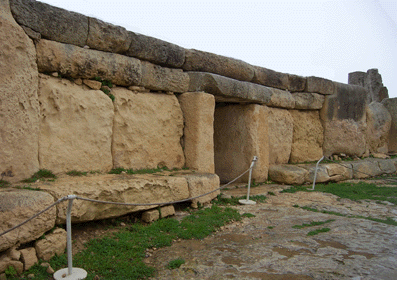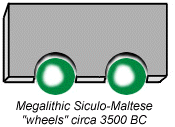...Best of Sicily presents... Best of Sicily Magazine. ... Dedicated to Sicilian art, culture, history, people, places and all things Sicilian. |
by Carlo Trabia | ||
Magazine Index Best of Sicily Arts & Culture Fashion Food & Wine History & Society About Us Travel Faqs Contact Map of Sicily |
It so happens that the Maltese islands were colonised by a civilisation which appears to have arrived from south-eastern Sicily and traded with peoples in Sicily, Calabria, Lampedusa and Tunisia. Interestingly, these early immigrants from Sicily constructed on Malta some of the oldest extant free-standing structures in the world - older than Stonehenge and the earliest Egyptian pyramids though more recent than the temple of Göbekli Tepe in Turkey. The very first megalithic Maltese temples may have been erected closer to 4,000 BC. Hagar Qim (shown) was probably completed a few centuries later. Wheels can be defined in various ways, but if we consider the simplest wheel to be something more than a rod or "roller," the early "Maltese" wheels actually conform to our most common, even modern, preconceptions. What happened is that our neolithic ancestors used rounded stones, fit into the matching (reverse) grooves of megalithic slabs, to move the gigantic liths and then place these into position. It must be said that they did not always move the stones in this way. More often, they probably "rolled" the stones atop a series of parallel cylindrical rods shaped from tree trunks. Some of the best "wheel" examples are at the Tarxien temple, near Valletta, with specimens displayed in Valletta's National Museum of Archaeology. The function of the rudimentary wheels is shown in the illustration, with the carved stone balls in green.
Oddly enough, nothing of this type has been discovered in Egypt or among the megalithic structures of north-western Europe. It remains to be seen whether these spherical wheels were even very efficient. We may speculate, for instance, that they had to be lubricated in some way for smooth operation. And were the inventors even Sicilian? There is no trace of them, and some historians believe that the temple builders left Malta or died out around the beginning of the island's Bronze Age (circa 2,500 BC in the central Mediterranean). The theory is that Malta's Bronze Age artefacts and structures seem to reflect a different culture, perhaps African, but this is far from certain. When the Phoenicians arrived, circa 750 BC, Malta was probably uninhabited. But the neolithic wheels, vestiges of an earlier era, remained. About the Author: Architect Carlo Trabia has written for this publication and others. | |
Top of Page |
 Did Sicilians invent the wheel?
We're talking about very ancient Sicilians, of course, probably the remote
ancestors of the Sicanians, before even the hypothetical Proto-
Did Sicilians invent the wheel?
We're talking about very ancient Sicilians, of course, probably the remote
ancestors of the Sicanians, before even the hypothetical Proto- It may seem a little
strange to find Sicilians claiming to have invented, of all things, the
wheel, which technologically changed the course of history. Without the
wheel, ancient Eurasian society would have developed much like the ancient
American cultures. In other words, no chariots, carts, gears or mechanical
clocks. We cannot say with certainty that a contemporary society developed
something similar at the same time as the Maltese, if not somewhat earlier.
But it so happens that the best-identified, best-preserved examples were
found in Malta.
It may seem a little
strange to find Sicilians claiming to have invented, of all things, the
wheel, which technologically changed the course of history. Without the
wheel, ancient Eurasian society would have developed much like the ancient
American cultures. In other words, no chariots, carts, gears or mechanical
clocks. We cannot say with certainty that a contemporary society developed
something similar at the same time as the Maltese, if not somewhat earlier.
But it so happens that the best-identified, best-preserved examples were
found in Malta.